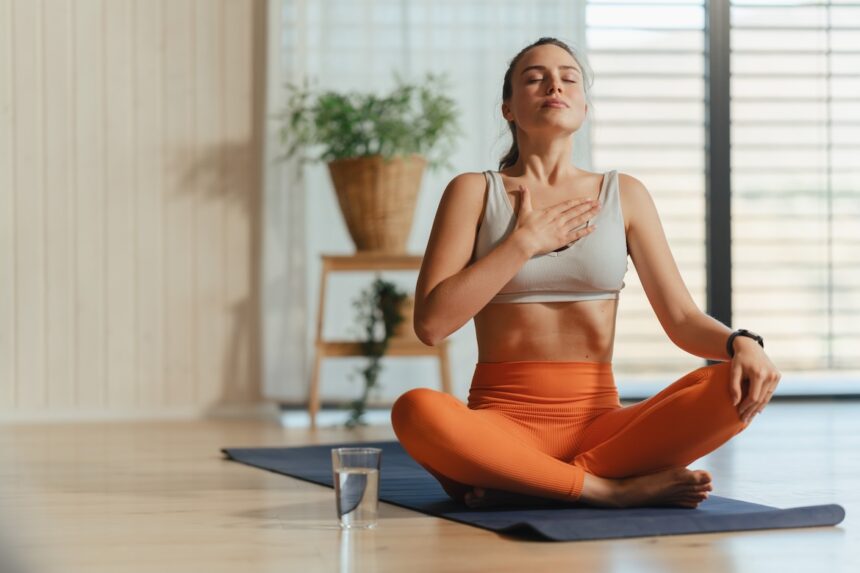If yoga has a PR individual, they’re doing an amazing job. In TV exhibits and flicks, the follow at all times appears so light and easy. And in some ways, it’s. The delicate music, the stretching, the give attention to the breath and the current second…it may be calming.
However yoga will be extra difficult than it appears. Some explicit positions will be difficult or uncomfortable—downward-facing canine at all times makes my wrists harm—and staying current is not any straightforward feat for these of us liable to nervousness thought traps.
Plus, do you know that the way you breathe throughout yoga issues? It’s not essentially a make-or-break factor, but it surely’s nonetheless a *factor*— so we requested a yoga teacher why it’s important to breathe the “proper” method and what that appears like.
Why respiration the appropriate method is vital throughout yoga
As talked about, respiration is a serious a part of yoga—and for a number of causes. The primary is bodily and rings true for every kind of motion.
“On a bodily degree, the breath brings oxygen to the physique, which helps with circulation and helps the flexibility to maneuver all through the follow,” says Kate Lombardo, E-RYT 500, co-founder and director at Yoga Renew and a licensed yoga trainer, coach, wellness educator, and mindset coach who focuses on vinyasa yoga sequencing, meditation, and constructive psychology.
The second is psychological and extra yoga-specific. It’s about one of many major execs of yoga: being within the current second. Lombardo says listening to your breath is a technique to streamline that course of.
“Once you carry focus to the breath, serious about every inhale and every exhale, you join the thoughts with the physique by bringing consciousness to one thing that’s taking place proper now, in actual time,” she explains. “This helps to focus and calm the thoughts, which in the end advantages the nervous system.”
Final however not least, sure kinds of respiration methods are higher than others relying on the kind of yoga. Give it some thought: The type of breath sample that’s needed for a extra lively type, like Vinyasa yoga, will differ from a extra meditative type, like Yin yoga. Every yoga kind (and respiration method) has its personal function and advantages.
“Once you carry focus to the breath, serious about every inhale and every exhale, you join the thoughts with the physique by bringing consciousness to one thing that’s taking place proper now, in actual time.” —Kate Lombardo, E-RYT 500
Find out how to breathe accurately throughout yoga
At the start, Lombardo suggests making certain that you simply’re respiration, interval. “So long as you’re respiration basically, that’s half the battle,” she says.
Some positions are extra bodily taxing, in which you’ll discover you’re holding your breath or not respiration nicely. Or, you might focus so nicely on respiration the appropriate method that it has the other impact. In these eventualities, you need to be extra intentional about checking that you simply’re respiration persistently.
Then, guarantee your breath patterns align together with your physique (which can or might not really feel pure). Principally, inhale whereas your physique is increasing and exhale when your physique is contracting, Lombardo says. A simple technique to bear in mind that is to think about your physique fill with air as you breathe in, and vice versa.
Lastly, remember the fact that the appropriate respiration method might rely on the kind of yoga you’re doing. Lombardo says:
- Pranayama, a limb of yoga that refers particularly to the breath, has all kinds of respiration practices which are meant for various occasions.
- For Vinyasa yoga and different practices which are extra bodily, an amazing begin is linking one breath (an inhale or exhale) to every motion.
- In slower-paced yoga, like restorative or Yin, begin with field respiration (inhale for 4 counts, maintain for 4 counts, then exhale for 4 counts) to calm your nervous system and hook up with your breath.
Upon getting extra expertise and luxury with respiration methods, you possibly can incorporate extra superior kinds of Pranayama, like alternate nostril respiration or Kapalabhati breath, a fast kind of respiration, Lombardo says.
In any case, the respiration piece is extra difficult than it could sound—so in case you battle or persist with the “simpler” methods, don’t beat your self up.
“Within the eight-limb path of yoga, Pranayama—or the follow that focuses particularly on the breath—comes after Asana, aka the bodily poses,” Lombardo says. “For those who take a look at yoga by way of this lens, the breath is definitely thought of a extra superior follow than the bodily motion.”










